- Home |
- About |
- Contact Us |
- Privacy |
- Newsletter |
- Shop |
- 🔍 Search Site
- Easter Color By Number Sheets
- Printable Easter Dot to Dot
- Easter Worksheets for kids
- Kindergarten
- All Generated Sheets
- Place Value Generated Sheets
- Addition Generated Sheets
- Subtraction Generated Sheets
- Multiplication Generated Sheets
- Division Generated Sheets
- Money Generated Sheets
- Negative Numbers Generated Sheets
- Fraction Generated Sheets
- Place Value Zones
- Number Bonds
- Addition & Subtraction
- Times Tables
- Fraction & Percent Zones
- All Calculators
- Fraction Calculators
- Percent calculators
- Area & Volume Calculators
- Age Calculator
- Height Calculator
- Roman Numeral Calculator
- Coloring Pages
- Fun Math Sheets
- Math Puzzles
- Mental Math Sheets
- Online Times Tables
- Online Addition & Subtraction
- Math Grab Packs
- All Math Quizzes
- 1st Grade Quizzes
- 2nd Grade Quizzes
- 3rd Grade Quizzes
- 4th Grade Quizzes
- 5th Grade Quizzes
- 6th Grade Math Quizzes
- Place Value
- Rounding Numbers
- Comparing Numbers
- Number Lines
- Prime Numbers
- Negative Numbers
- Roman Numerals
- Subtraction
- Add & Subtract
- Multiplication
- Fraction Worksheets
- Learning Fractions
- Fraction Printables
- Percent Worksheets & Help
- All Geometry
- 2d Shapes Worksheets
- 3d Shapes Worksheets
- Shape Properties
- Geometry Cheat Sheets
- Printable Shapes
- Coordinates
- Measurement
- Math Conversion
- Statistics Worksheets
- Bar Graph Worksheets
- Venn Diagrams
- All Word Problems
- Finding all possibilities
- Logic Problems
- Ratio Word Problems
- All UK Maths Sheets
- Year 1 Maths Worksheets
- Year 2 Maths Worksheets
- Year 3 Maths Worksheets
- Year 4 Maths Worksheets
- Year 5 Maths Worksheets
- Year 6 Maths Worksheets
- All AU Maths Sheets
- Kindergarten Maths Australia
- Year 1 Maths Australia
- Year 2 Maths Australia
- Year 3 Maths Australia
- Year 4 Maths Australia
- Year 5 Maths Australia
- Meet the Sallies
- Certificates

Doubling and Halving
(online math practice), loading...please wait.
This simple game has been designed to help your child to practice their doubling and halving with a range of different numbers.
Step 1) Type your name.
Step 2) Choose your number values.
Step 3) Click Start!
Please give feedback on our Doubling and Halving Practice Zone at the bottom of the page.
Number values:
Mode: Individual Class/Group
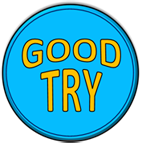
Correct Answers
Percentage Correct
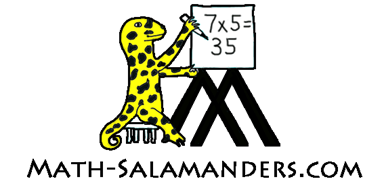
For full functionality of this site it is necessary to enable JavaScript.
Here are the instructions how to enable JavaScript in your web browser .
Practice Zones
In our practice zones, you get the chance to practice your math skills online with instant feedback.
Once you have done a timed quiz, you can see your results and print out your achievements.
The achievement levels are based on the percentage correct and the time taken.
- Gold awards are for outstanding achievement: 94% or higher;
- Silver awards represent very good acheivement: 85% or above;
- Bronze awards represent good achievement: 70% or above.
As well as the percentage of questions answered correctly, the awards are also dependent on the time taken to answer the questions!
These quizzes are great for...
- benchmarking against future progress or setting targets;
- class competitions;
- assessing specific mental calculation skills.
The quizzes can also be tailored to the specific skills that you want to develop.
You can set each quiz to Individual or Class/Group mode.
Individual Mode
When working in Individual Mode, you can:
- change the settings between each game to tailor them to your needs;
- click the Results button to see which questions you got right, and what your mistakes were;
- print out your results to show what you have achieved, and to try to beat your score next time.
Class/Group Mode
This mode if for a group/class of kids sharing the same computer.
When working in Group mode, you can:
- view the top 3 scores for your group;
- click on the Results button to see all the scores for your group;
- sort the results easily so that you can see who has achieved the learning objective and who needs more practice or support;
- click on the Reset button to get ready for the next player;
- clear all the scores and settings by refreshing the page.
In Group Mode, you cannot see how students answered individual questions - you can only see the results for your group.
In Group Mode the settings are locked to prevent any tampering.
If you wish to change the settings, then refresh the page in your browser - you will lose all your data when this happens!
Please note: you must have Javascript enabled on your browser settings for the practice zones to work. If you would like help with this, please use the link below.
Help me to enable javascript
More Recommended Math Worksheets
Take a look at some more of our worksheets similar to these.
Fractions on a number line - halves
Here you will find a selection of number line Fraction Worksheets.
Using these sheets will help your child to:
- understand a half as a number.
All the free math sheets in this section support the Elementary Math benchmarks for 2nd Grade.
- Fraction Math Worksheets - understanding a half
- position fractions on a number line;
- understand the value of fractions and mixed numbers.
All the printable fraction worksheets in this section support the Elementary Math benchmarks for 3rd Grade.
- Fraction Number Line Worksheets
Online Learning Math Hub
Return from Doubling and Halving Practice Zone to Math Salamanders Home Page
Math-Salamanders.com
The Math Salamanders hope you enjoy using these free printable Math worksheets and all our other Math games and resources.
We welcome any comments about our site or worksheets on the Facebook comments box at the bottom of every page.
New! Comments
TOP OF PAGE
© 2010-2024 Math Salamanders Limited. All Rights Reserved.
- Privacy Policy
- Copyright Policy

- Home Learning
- Free Resources
- New Resources
- Free resources
- New resources
- Filter resources
- Childrens mental health
- Easter resources
Internet Explorer is out of date!
For greater security and performance, please consider updating to one of the following free browsers
Doubling and Halving – Reasoning and Problem Solving
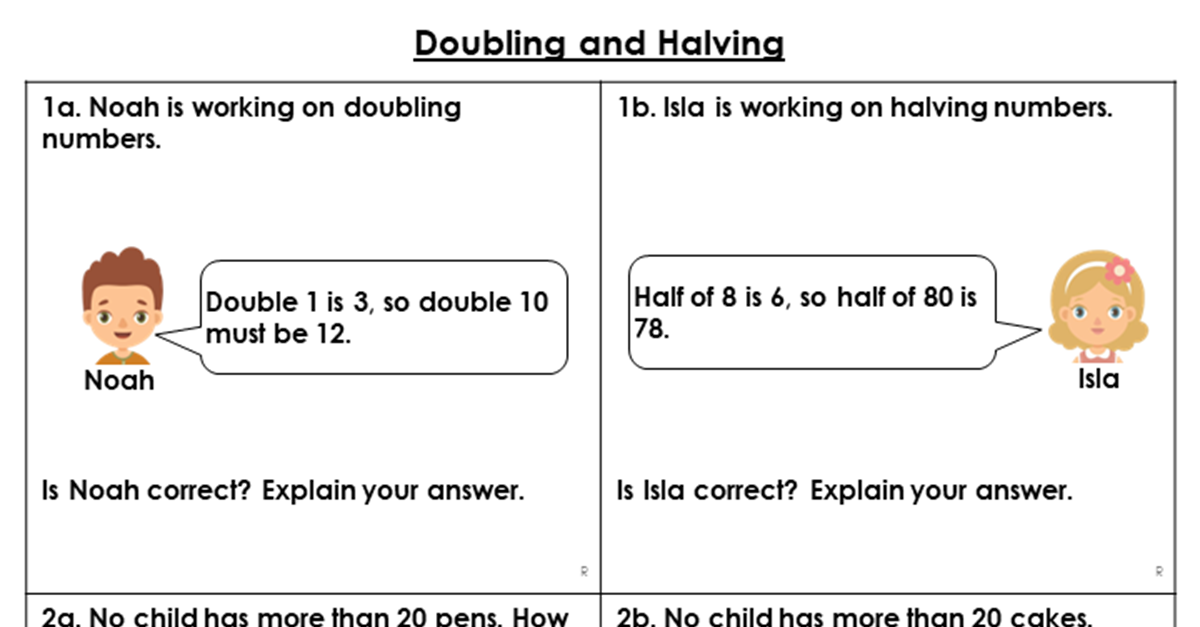
Doubling and Halving - Reasoning and Problem Solving
This worksheet includes a range of reasoning and problem solving questions for pupils to practise the main skill of doubling and halving.

Not a member? Sign up here.
What's included in the pack?
Doubling and Halving reasoning and problem solving worksheet Answer sheet
National Curriculum Objectives:
This resource is available to download with a Premium subscription.
Our Mission
To help our customers achieve a life/work balance and understand their differing needs by providing resources of outstanding quality and choice alongside excellent customer support..
Yes, I want that!
Keep up to date by liking our Facebook page:
Membership login, stay in touch.
01422 419608
[email protected]
Interested in getting weekly updates from us? Then sign up to our newsletter here!

Information

- Cookie Policy
- Privacy Policy
- Terms and Conditions
Copyright: Classroom Secrets 2024
Company number: 8401067
VAT number: 248 8245 74
- Terms & Conditions
Designed by Classroom Secrets
Commutativity (part 2), doubling and halving
Spine 2: Multiplication and Division – Topic 2.5
Introduction
Explore how one multiplication equation can have two different grouping interpretations (e.g., an equation from the two times table can be interpreted in terms of groups of two, or two equal groups); make connections between the two times table, doubling and halving.
Teaching points
- Teaching point 1 : The same multiplication equation can have two different grouping interpretations. Problems about two/five/ten equal groups can be solved using facts from the two/five/ten times table. (commutativity)
- Teaching point 2 : If two is a factor, knowledge of doubling facts can be used to find the product; problems about doubling can be solved using facts from the two times table.
- Teaching point 3 : Halving is the inverse of doubling; problems about halving can be solved using facts from the two times table and known doubling facts.
- Teaching point 4 : Products in the ten times table are double the products in the five times table; products in the five times table are half of the products in the ten times table.
Teacher Guide
Representations, all year 2 files, related pages.
Is there anything wrong with this page?
Subscribe to our newsletter
Mastery-Aligned Maths Tutoring
“The best thing has been the increase in confidence and tutors being there to deal with any misunderstandings straight away."
FREE daily maths challenges
A new KS2 maths challenge every day. Perfect as lesson starters - no prep required!

20 Word Problems For Year 4: Develop Their Problem Solving Skills Across Single and Mixed KS2 Topics
Emma Johnson
Word problems for Year 4 play an important role in Year 4 maths. In Year 4, the main focus is to ensure that pupils are becoming more fluent with whole numbers and the four operations. Students work to develop efficient written methods and to be accurate with their calculations. Pupils in Year 4 are exposed to a wider range of problem-solving questions and progress from one to two-step problems.
It is important that all children are given regular opportunities to access reasoning and word problem style questions. Fluency, reasoning and problem solving should be intertwined through every lesson, with all children having the opportunity to tackle each of these question types.
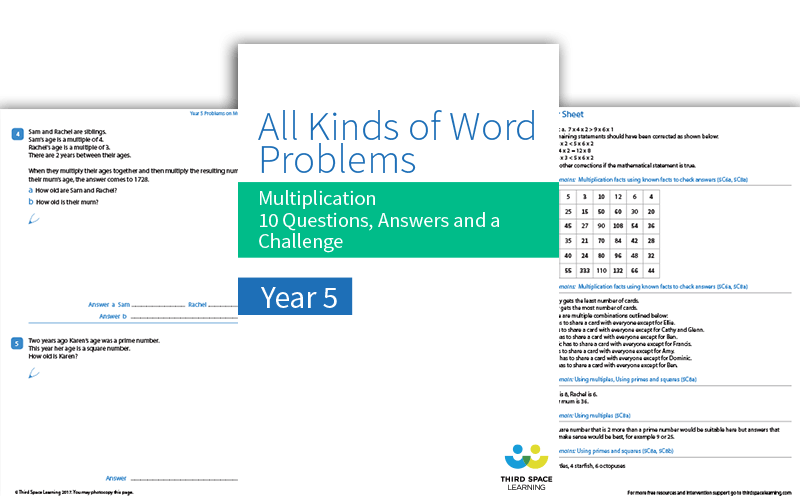
All Kinds of Word Problems Multiplication
Strengthen your students' problem solving and multiplication skills with this pack of multiplication word problems
Place value
Addition and subtraction , multiplication and division, fractions, decimals and percentages, measurement, why are word problems important in year 4 maths, how to teach problem solving in year 4, addition word problems for year 4, subtraction word problems for year 4, multiplication word problems for year 4, division word problems for year 4, fraction and decimal word problems in year 4, time word problems in year 4, multi-step word problems in year 4., more primary word problems resources.
There can sometimes be a tendency for reasoning and problem solving questions to be treated as extension activities for only the higher attaining pupils to attempt, but children of all abilities need to be accessing them on a regular basis.
To help you with this, we have put together a collection of 20 word problems aimed at Year 4 pupils. For more Year 4 maths resources, take a look at our collection of Year 4 maths worksheets .
Year 4 Maths Word Problems in the National Curriculum
In Year 4, pupils progress from solving one-step problems, to also being exposed to two-step problems across a range of topics, as set out in the National Curriculum.
Solve word problems involving counting in multiples of 6,7,9, 25 and 100; finding 1000 more or less than a given number; counting backwards through 0 to include negative numbers; ordering and comparing numbers beyond 1000 and rounding numbers to the nearest 10. 100 and 1000
Solve addition and subtraction word problems with up to 4 digits, including two-step word problems, deciding which operations and methods to use and why.
Solve problems involving multiplying and adding, including using the distributive law to multiply two-digit numbers by 1 digit, integer scaling problems and harder correspondence problems.
Solve problems involving increasingly harder fractions word problems to calculate quantities, and fractions to divide quantities, including non-unit fractions where the answer is a whole number. Also Solve simple measure and money problems involving fractions and decimals to 2 decimal places.
Solve problems involving converting from hours to minutes, minutes to seconds, years to months, weeks to days.
Solve comparison, sum and difference problems using information presented in bar charts, pictograms, tables and other graphs.
Word problems are increasingly important as pupils move through Key Stage 2. As they become more confident with some of the core concepts pupils need to be applying this knowledge to a range of situations. By the end of Year 4, pupils should have memorised their multiplication tables up to and including the 12 times table and should be showing precision and fluency in their work.
Word problems in Year 4 should be fun and engaging for students. There are many ways to do this, including:
- acting out the problem;
- using manipulatives and visual images to help children understand the maths within the problem;
- use of talk partners to encourage children to discuss the question and share strategies for reaching a solution;
- using relatable problem solving situations.
Children need to be encouraged to read word problem questions carefully, to ensure they have identified the key information needed to be able to solve the problem. Pupils need to think about what they already know and how that information can help them to answer the question. They should also be encouraged to draw pictures and visual images, where appropriate, to help them to understand what the question is asking.
Here is an example:
A shop has an 8m roll of fabric.
The first customer buys 125cm of fabric and the second customer buys 3m from the same roll.
How much fabric is left on the roll, once the two customers have taken theirs?
How to solve:
What do you already know?
- The amount the first customer buys is given in cm, the amount the second customer buys is given in m. These needed to be converted to the same unit.
- Pupils in Year 4 need to be able to convert cm to m and vice versa. In this question, both the cm can be given as m or the m changed to cm to solve it.
- Once the units are the same, the two amounts need to be added together, to work out the total amount bought by the two customers.
- We can see this is a two-step question. To calculate how much fabric is left on the roll, the total amount bought by the two customers needs to be subtracted from the initial amount of fabric on the roll.
How can this be drawn/represented pictorially?
We can draw a bar model to represent this problem:

- To calculate the total amount of fabric bought, we need the units to be the same. We can either calculate in cm (300cm + 125cm = 425cm) or in m (3m + 1.25m = 4.25m)
- The amount of material bought needs to be subtracted from the original amount. This can again be solved in m or cm. Either in m: 8m – 4.25m = 3.75m or in cm: 800cm – 425cm = 375cm
- The total amount of material left is 3.75m or 375cm
In Year 4, addition word problems involve questions up to 4-digit numbers. They can include one and two-step addition and incorporate a range of concepts, such as measures and money word problems
Addition question 1
It is 4164 miles to travel from London to Doha and 3266 miles to travel from Doha to Bangkok.
How far is it to travel from London to Bangkok, if the flight stops in Doha first?
Answer (1 mark): 7430 miles
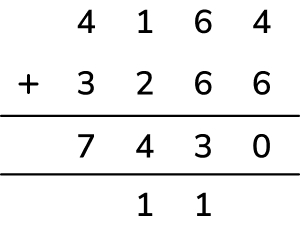
Addition question 2
Fill in the missing numbers in this calculation.
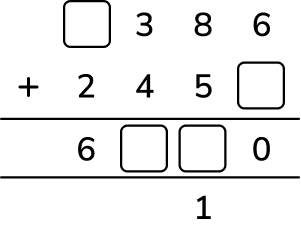
Answer (1 mark): 6840
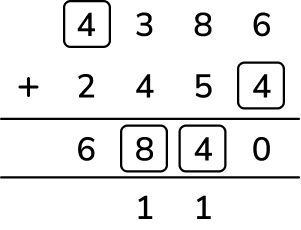
Addition question 3
On Saturday, 5486 fans attended a football game and 3748 fans attended a rugby game.
How many fans watched the two games in total?
Answer (1 mark): 9234
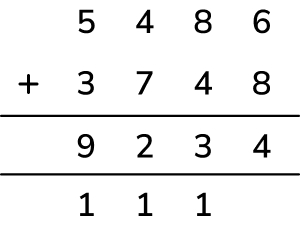
Subtraction word problems in Year 4, also involve numbers up to 4-digits, including both one and two-step problems, covering a range of concepts. By this stage, children should be confident in estimating and using the inverse, to check calculations.
Subtraction question 1
3241 people visited the zoo on Saturday.
On Sunday 2876 people visited.
How many more people visited the lake on Saturday than on Sunday?
Answer (1 mark): 365
3241 – 2876 = 365
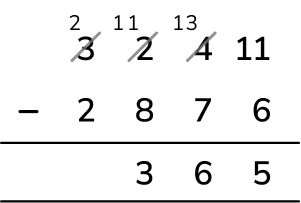
Subtraction question 2
A teacher prints out 1242 worksheets in a term.
If 435 were maths worksheets, how many did she print out for the other subjects?
Answer (1 mark): 807
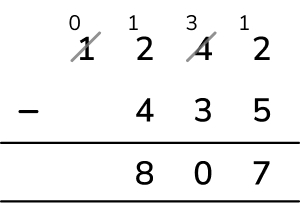
Subtraction question 3
The temperature in Toronto dropped to minus 15 degrees celcius in December.
In July the temperature was 47 degrees celsius warmer than it was in December. What was the temperature in July?
Answer (1 mark): 32 degrees warmer
47 – 15 degrees = 32 degrees celsius
Counting on 47 degrees from minus 15 degrees = 32 degrees celsius
In Year 4, multiplication word problems can include recalling facts for times tables up to 12 x 12 and multiplying two and three-digit numbers by a 1-digit number, using formal written layout.
Multiplication question 1
All the pupils in Year 4 complete a mental maths test.
27 pupils score 9 marks out of 10.
What is the total number of marks scored by the 27 pupils?
Answer (1 mark): 243
27 x 9 = 243
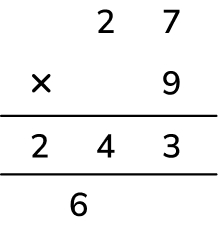

Multiplication question 2
Year 3 and 4 children from a local primary school go on a school trip.
Six mini buses are used to transport the children.
There are 17 children on each minibus.
How many children go on the school trip?
Answer (1 mark): 102
17 x 6 = 102 children
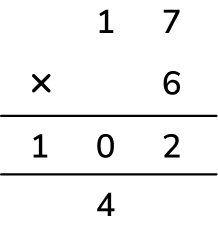
Multiplication question 3
Biscuits come in packs of 18.
Mrs Smith buys 8 packs for the parents at the Y4 maths workshop.
How many biscuits does she buy altogether?
Answer (1 mark): 144 biscuits
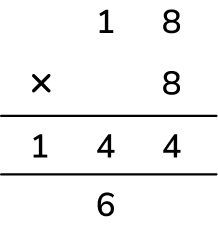
Division word problems in year 4 require pupils to be able to recall division facts for multiplication tables up to 12 x 12. Formal written method of division isn’t a requirement until Year 5 however, many schools choose to teach the formal method in Year 4. Pupils need to understand the concept of grouping and sharing and to understand the link between multiplication & division.
Division question 1
Sam has 28 friends coming to his birthday party.
Each child will receive a cupcake, which come in packs of 4.
How many packs of cupcakes will Sam need to buy?
Answer (1 mark): 7 packs
28 ÷ 4 = 7
Division question 2
4 children raised £96 between them on a sponsored walk.
If they split the money evenly between the four of them, how much did each pupil raise?
Answer (1 mark): £24 each
96 ÷ 4 = 24
Division question 3
Ahmed is thinking of a number
He says, ‘when I divide my number by 12, the answer is 108.
What number was Ahmed thinking of?
Answer (1 mark): 9
108 ÷ 12 = 9
In Year 4, decimal and fraction problems involve increasingly harder fractions to calculate quantities and fractions to divide quantities, including non-unit fractions, where the answer is a whole number. Decimal word problems include measure and money problems involving fractions and decimals up to 2 decimal places.
Fraction and decimal question 1
Jamie has 18 sweets.
He gives \frac{1}{6} of the sweets to his friend and keeps the rest himself.
How many sweets does Jamie have now?
Answer (1 mark): 15 sweets
\frac{1}{6} of 18 = 3
18 – 3 = 15
Fraction and decimal question 2
Jaxon collected 36 conkers.
\frac{1}{4} of the conkers fell out of a hole in his bag, when he was walking home.
How many conkers did Jaxon have left, when he got home?
\frac{1}{4} of 36 = 9
36 – 9 = 37 or \frac{3}{4} of 36 = 29 (3 x 9)
Fraction and decimal question 3
Sara ate \frac{3}{12} of a chocolate bar and gave \frac{2}{12} to her friend.
What fraction of the chocolate bar did she have left?
Answer (1 mark): \frac{7}{12}
In Year 4, time word problems include: converting from hours to minutes, minutes to seconds, years to months and weeks to days.
Time question 1
A cake was put in the oven at 4:35pm and taken out at 4:57pm.
How long was the cake in the oven?
Answer (1 mark): 22 minutes
57-35 = 22 minutes
Using an number line:

Time question 2
It took Evie 25 minutes to complete a page of number problems.
If she started at 2:45pm. What time did she finish?
Answer (1 mark): 3:10pm
In Year 4, children are introduced to multi-step word problems requiring up to two steps. These problems cover a range of concepts, including the four operations, fractions, decimals and measures.
Third Space Learning’s online one-to-one tutoring frequently incorporates multi-step questions to test students’ knowledge and problem solving skills. Our personalised tutoring programme works to identify gaps in students’ learning, fill those gaps, reinforce students’ knowledge and build confidence.
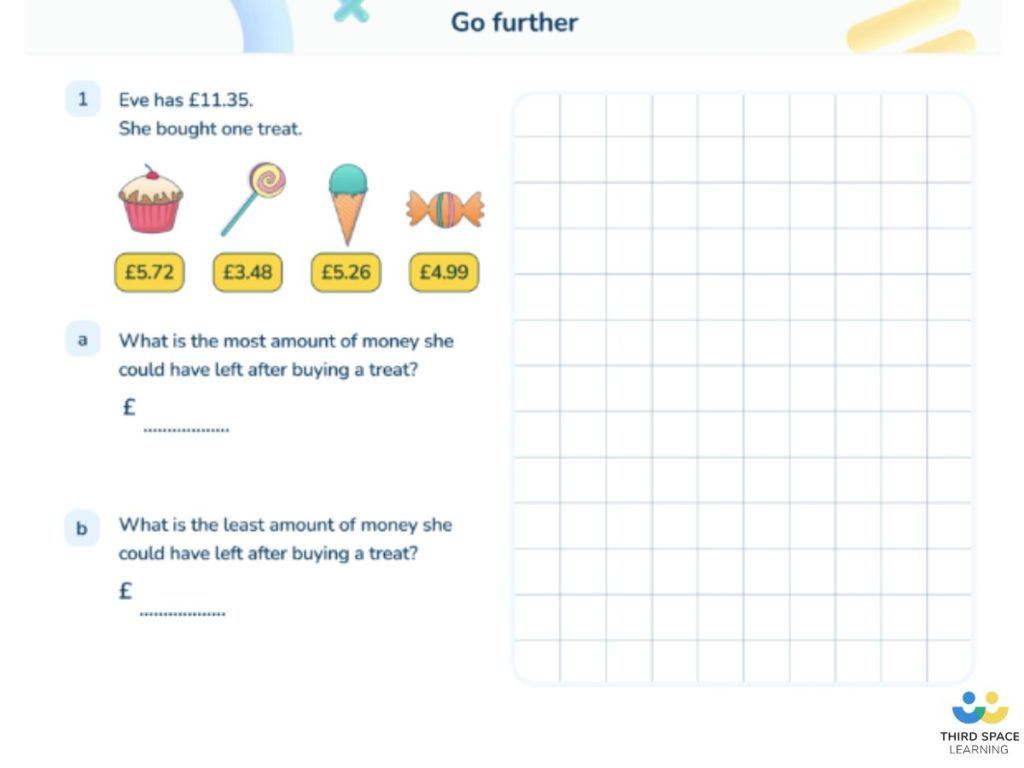
Multi-step question 1
There are 6 handwriting pens in each pack.
A class has 30 children and each child needs 2 handwriting pens.
How many packs will the teacher need to buy?
Answer (2 marks): 10 packs of handwriting pens.
30 x 2 = 60
Multi-step question 2
Sophie has £4.50.
She buy 3 books at a carboot sale, costing 50p, 65p and £1.20.
How much money does she have left?
Answer (2 marks): £2.15 left
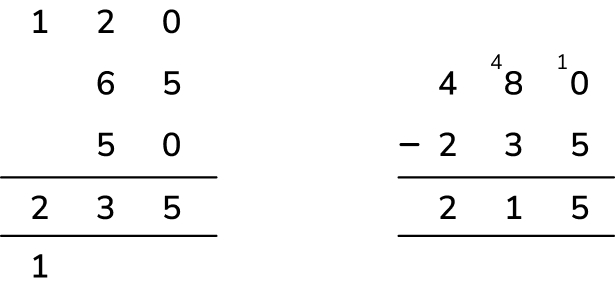
Multi-step question 3
Abullah is thinking of a number.
He doubles the number and adds 7.
He gets an answer of 25.
What was his original number?
Answer (2 marks): 9
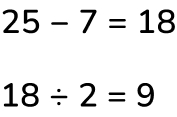
Third Space Learning offers word problems for all primary year groups. Take a look at our word problems for year 3 , word problems for year 5 and word problems for year 6 . Our word problems span a range of topics such as ratio word problems and percentage word problems .
DO YOU HAVE STUDENTS WHO NEED MORE SUPPORT IN MATHS?
Every week Third Space Learning’s specialist primary maths tutors support thousands of students across hundreds of schools with weekly online 1 to 1 maths lessons designed to plug gaps and boost progress.
Since 2013 these personalised one to one lessons have helped over 150,000 primary and secondary students become more confident, able mathematicians.
Learn how tutors develop pupils’ maths fluency or request a personalised quote for your school to speak to us about your school’s needs and how we can help.
Related articles

Maths Problem Solving: Engaging Your Students And Strengthening Their Mathematical Skills

Free Year 7 Maths Test With Answers And Mark Scheme: Mixed Topic Questions

What Is A Number Square? Explained For Primary School Teachers, Parents & Pupils
What Is Numicon? Explained For Primary School Teachers, Parents And Pupils
FREE Guide to Maths Mastery
All you need to know to successfully implement a mastery approach to mathematics in your primary school, at whatever stage of your journey.
Ideal for running staff meetings on mastery or sense checking your own approach to mastery.
Privacy Overview
Popular searches in the last week:
Problem-solving maths investigations for year 4.
Hamilton provide an extensive suite of problem-solving maths investigations for Year 4 to facilitate mathematical confidence, investigative inquiry and the development of maths meta skills in 'low floor – high ceiling' activities for all.
Explore all our in-depth problem solving investigations for Year 4 .
Use problem-solving investigations within every unit to encourage children to develop and exercise their ability to reason mathematically and think creatively.
Investigations provide challenges that offer opportunities for the development of the key mathematical skills while deepening conceptual understanding. They are designed to be accessible in different ways to all children. An added bonus is the substantial amount of extra calculation practice they often incorporate! The problems are designed to help children identify patterns, to explore lines of thinking and to reason and communicate about properties of numbers, shapes and measures.
Hamilton provide a mix of our own specially commissioned investigations, that include guidance for teachers together with a child-friendly sheet to guide your pupils through the investigation, as well as links to investigations on other highly regarded websites.
I am very grateful for Hamilton Trust resources, particularly the maths investigations. Julia, teacher in Wiltshire
You can find Hamilton's investigations for Year 4:
- Individually, they are incorporated into every unit in our Year 4 flexible maths blocks .
- Collectively, they appear on our resources page where you can explore all our in-depth problem solving investigations for Year 4 .
Do read our extensive range of advice for more information about the investigations and for tips on how to use them effectively.
Hamilton’s problem-solving investigations are 'low floor, high ceiling' activities that give all children opportunities to develop mastery and mathematical meta-skills. Explore a set for a whole year group.
Hamilton’s Problem-solving Investigations provide school-wide solutions to the challenges of building investigative skills from Early Years to Year 6.
This site uses cookies to give you the most relevant information. Learn more
Log in or sign up to get access to this resource
School subscription, reduce teacher workload.
From £155 (+ VAT) per year. Access to all key stages for multiple users.
Individual Subscription
For inspirational teaching.
Just £45 (£37.50 + VAT) per year to get access to all resources.
Early Career Teacher
Develop your teaching.
Just £33 (£27.50 + VAT) to get access to all resources for 2 years.
Taster Account
100s of resources.
Register to access all free resources.
Already subscribed?
Log in to get access.
- International
- Schools directory
- Resources Jobs Schools directory News Search

Differentiated word problems for doubling Y2
Subject: Mathematics
Age range: 5-7
Resource type: Worksheet/Activity
Last updated
30 May 2014
- Share through email
- Share through twitter
- Share through linkedin
- Share through facebook
- Share through pinterest

Tes classic free licence
Your rating is required to reflect your happiness.
It's good to leave some feedback.
Something went wrong, please try again later.
Good resource
Empty reply does not make any sense for the end user
lisaarnold84
brilliant resource
Anon54596968634538510
Looks really good. Looking forward to trying it out. Many thanks for sharing...
Looks good, will try with Y2 tomorrow. I love that you let us share so that we can edit - change names etc, also means I can combine with other Q for lower attainers. Great that the Q can be cut up- I will ask children to stick in their books as rarely does work fit exactly the following year so no need to hang onto the Q. THANKYOU !
Report this resource to let us know if it violates our terms and conditions. Our customer service team will review your report and will be in touch.
Not quite what you were looking for? Search by keyword to find the right resource:

IMAGES
VIDEO
COMMENTS
Twinkl Parents Ages 5 - 11 Everything You Need for Children Aged 5 - 11 Parents Ages 5 - 6 (Year 1) Year 1 Maths Problem solving/Maths Investigations. Make maths fun with these doubling and halving differentiated worksheets and doubling and halving challenge cards! Each card features a different challenge with visual representations to help ...
maths problem solving. Helpful. Thank you for your feedback. emmathomas1 - Verified member since 2015 . Reviewed on 18 June 2015 . sen. Helpful. ... doubling and halving year 4 . doubling challenge cards . doubling and halving year 5 . doubles word problems . halving ...
This simple game has been designed to help your child to practice their doubling and halving with a range of different numbers. Step 1) Type your name. Step 2) Choose your number values. Step 3) Click Start! Please give feedback on our Doubling and Halving Practice Zone at the bottom of the page. Doubling & Halving Zone.
52 Top "Doubling And Halving Year 4" Teaching Resources curated for you. Doubling and Halving Worksheets 9 reviews. Year 4 Number: Mental Multiplication and Division Lesson 3. LKS2 Halving to Divide by 4, 8, and 16 Activity Pack 1 review. The Grinch: Maths Codebreaker Activity Sheets [Ages 7-9] 1 review. Using Short Division to Solve Problems ...
Investigating Doubling and Halving. An activity to match Y4 Maths, Block B, Unit 3. The task is differentiated for a top-set maths class, looking to identify patterns in sequences (i.e. halving or doubling) and then to complete the sequence. Further activities include following rule to create their own sequence and then finding a rule in a ...
Key learning points. In this lesson, we will explain and model mental strategies for doubling and halving by using our understanding of multiplication and division. We will also use our doubling and halving strategies to multiply and divide by four and eight. By the end of this lesson, we would hope that everyone will be confident in explaining ...
Doubling and Halving reasoning and problem solving worksheet. Answer sheet. National Curriculum Objectives: Mathematics Year 2: (2C6) Recall and use multiplication and division facts for the 2, 5 and 10 multiplication tables, including recognising odd and even numbers. This resource is available to download with a Premium subscription.
Key Stage 1. Maths. Measures (1): Length and mass. To solve problems involving doubling and halving.
In-depth Investigation: Doubling forever Children double numbers up to 20 and look for duplicate sequences. This problem-solving investigation is part of our Year 4 Multiplication and Division block. Each Hamilton maths block contains a complete set of planning and resources to teach a term's worth of objectives for one of the National ...
Halving Even Numbers to 20 (Becki Smith) DOC. Diamond Doubles (Laura Martin) Ducky Doubles (Near Doubles) (Hilary Rodley) PDF. Doubling & Halving Bingo (Karen Bentley) DOC. Doubles and Halves Dartboard (Ellie Olmer) Doubles and Halves Dartboard (EO/Lydia Winwood) DOC. Double Dominoes Cards (Alison Timbey) PDF.
Differentiated word problem booklets involving doubling and halving. Creative Commons "Sharealike" Reviews. 4.8. Something went wrong, please try again later. anloftus. 4 years ago. report. 5. Great worksheets. Thank you so much for sharing. Show replies. Hide replies. Empty reply does not make any sense for the end user. Submit reply ...
Problems about two/five/ten equal groups can be solved using facts from the two/five/ten times table. (commutativity) Teaching point 2: If two is a factor, knowledge of doubling facts can be used to find the product; problems about doubling can be solved using facts from the two times table. Teaching point 3: Halving is the inverse of doubling ...
Part of a comprehensive PlanIt Maths lesson pack, you can use these differentiated two-step problem-solving activity sheets to help students practise addition and subtraction skills. Tasks are designed to allow students to experience worded problems with two-step problem solving involving addition and subtraction. They meet the national curriculum aim 'Solve addition and subtraction two-step ...
Word problems for Year 4 play an important role in Year 4 maths. In Year 4, the main focus is to ensure that pupils are becoming more fluent with whole numbers and the four operations. Students work to develop efficient written methods and to be accurate with their calculations. Pupils in Year 4 are exposed to a wider range of problem-solving ...
The problem-solving investigations below match Hamilton's weekly maths plans. We now also provide Year 4 maths as short blocks.We will eventually be phasing out the plans, as we believe our short blocks offer you all of the same advantages and more, including the integration of the problem-solving investigations into each unit of study.
Twinkl Parents Ages 5 - 11 Everything You Need for Children Aged 5 - 11 Parents Ages 5 - 6 (Year 1) Year 1 Maths Problem solving/Maths Investigations. Make maths fun with these doubling and halving differentiated worksheets and doubling and halving challenge cards! Each card features a different challenge with visual representations to help ...
By Nick Barwick - 7 Aug 2018. Hamilton provide an extensive suite of problem-solving maths investigations for Year 4 to facilitate mathematical confidence, investigative inquiry and the development of maths meta skills in 'low floor - high ceiling' activities for all. Explore all our in-depth problem solving investigations for Year 4.
Problem solving. Find out how you can use maths to solve your problems. What is a number sequence? Discover how numbers can be connected in a pattern and see if you can solve the puzzle. Year 4 ...
Our expertly-made year 4 two-step problems resources are made to align with the curriculum topic of Number - Addition and Subtraction. They support the curriculum's aim: "solve addition and subtraction two-step problems in contexts, deciding which operations and methods to use and why". Have a look around and explore our assortment of year 4 ...
Differentiated word problems for doubling Y2. Can be done as a worksheet, but I personally cut up the sheets, place them in differentiated boxes at the front of the class, and get the children to write their answers in their books. Once a child has done one problem, they can go back to their box and collect a new one. Good resource.
Double 8 is 16 (not 18). Double 10 is 20 (not 19). Double four is 8 (not 6). 9a. Double ten is 20 because 10 + 10 = 20. Double 7 is 14 because 7 + 7 = 14. Double six is 12 because 6 + 6 = 12. Double four is 8 because 4 + 4 = 8. Reasoning and Problem Solving Making Doubles.
Developed as part of our award-winning PlanIt scheme of work, this lesson is the first in a series of three on addition and subtraction problem-solving for Year 4 Maths. For more resources like this two-step problem-solving lesson, take a look at the following downloadable packs, lesson 2 and 3 in this series:
These year 4 maths problems challenge cards are designed by our team of experienced teachers in line with the maths national curriculum standards. This means that the exercises included will challenge pupils to further develop key maths skills. Here are some of the curriculum aims, which children need to meet by the end of year 4.